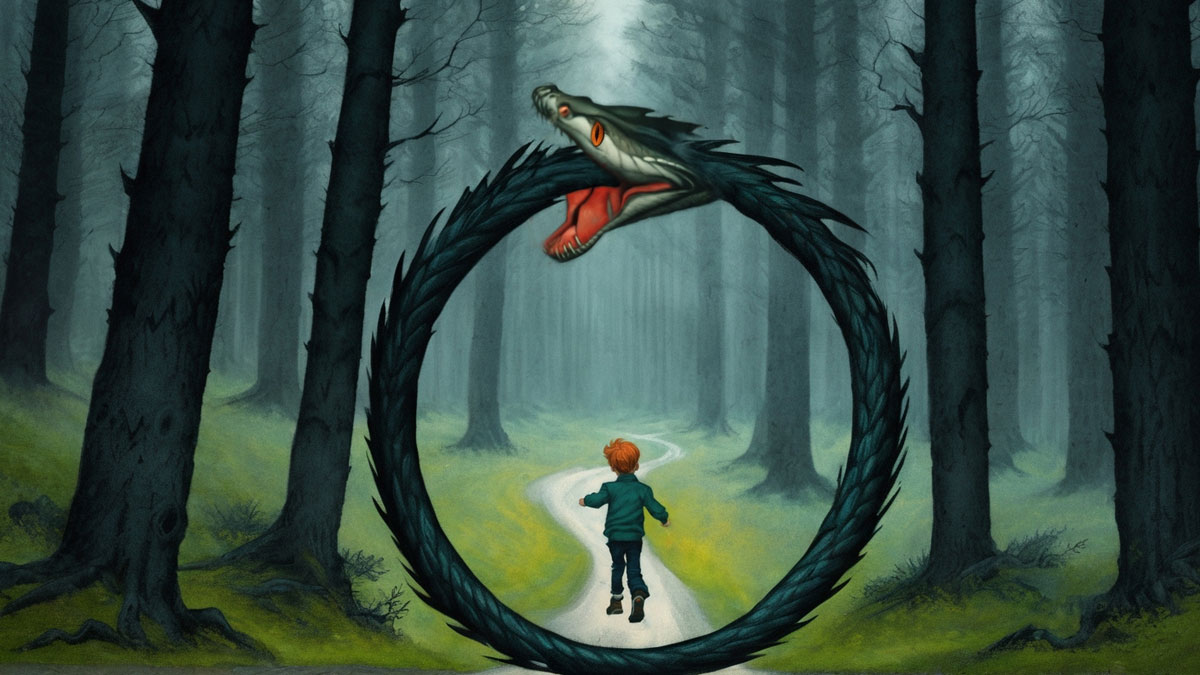The Hoop Snake is a cryptid serpent from folkloric traditions across the U.S. and Canada.
The Hoop Snake also appears in the ancient traditions of cultures from other parts of the world, including Europe, Africa, Asia, and Australia.
A cosmic serpent that forms a hoop by biting or holding its tail in its mouth occurred in Ancient Egyptian mythology. It was known in Greek mythology as the Ouroboros and in Japan as tsuchinoko.
Variants of the Hoop Snake myth also occur in the vodoun traditions of the Fon people of modern-day Benin Republic, where it is known as Ayida-Weddo.
Description
The earliest reference to the Hoop Snake is usually credited to an account by John Ferdinand Smyth Stuart in A Tour in the United States of America.
Smyth (also known as J.F.D Smyth) describes a snake that forms a loop or circle when it pursues prey.
However, Karl Patterson Schmidt (1925) traced the origin of the Hoop Snake back to previous accounts about Horn Snakes first documented in a 1688 letter by John Clayton to the Royal Society of London.
In his satirical book Fearsome Creatures of the Lumberwoods, William Thomas Cox (1910) christened the Hoop Snake Serpenscirculousus caudavenenifer.
The satirist described the mythical creature as a feared “circular engine of destruction” that has the habit of holding its tail in its mouth and rolling at incredible speeds in pursuit of prey. The tail end of the mythical creature consists of a stinger with deadly venom.
Tex O’Reilly also described the Hoop Snake in his Pecos Bill tales published in the 20th century. O’Reilly claimed he adapted his stories from the folklore of the American frontier era of westward expansion (17th-early 20th century).
The Hoop Snake holds its tail in its mouth
Generally, North American folklore describes the Hoop Snake as a serpent that can crawl on its belly like any other. But it may also form a hoop, ring, or wheel by holding its tail in its mouth.
It then pursues its prey by rolling along on the ground like a wheel.
When it catches the prey, it attacks it with its poisoned tail. You may escape the poison tail attack by ducking behind a tree. If the poison tail hits the tree, it withers immediately due to the action of the venom.
The Hoop Snake only forms a ring when pursuing prey. It crawls on its belly when escaping from attackers.
Sightings and Tales
The Hoop Snake is unknown to zoology, but alleged sightings have occurred in the U.S. and Canada.
In the U.S., most claimed sightings reportedly come from the St. Croix River Valley area on the border of Minnesota and Wisconsin. Other reports have come from Wake County in North Carolina.
In Canada, reports have come from Prince Edward Island and Kamloops, British Columbia.
Claimed sightings have sparked controversy in the past.
The American herpetologist and naturalist Raymond Ditmars (1876-1942) offered a prize of $10,00 for anyone who could provide evidence of the alleged species.
No one has yet claimed the generous reward.
What is the Hoop Snake?
Some biologists have attempted to suggest known species that might have inspired the Hoop Snake legend.
The best candidates so far include:
Sidewinder snake
The sidewinder snake (Crotalus cerastes), also known as the horned rattlesnake, is a venomous pit viper found in the arid regions of the Southwestern United States and Northwestern Mexico.
Adults grow only about 20-32 inches in length. They are known as sidewinders because of their peculiar rapid sideways method of locomotion on the loose sand of desert environments.
Mud snakes
Mud snakes (Farancia abacura) are a nonvenomous, semiaquatic species native to the southeastern states.
They prefer wet conditions. Thus, they live close to fresh or brackish wetlands, swamps, or bogs where they can burrow into the soft muddy soil.
They prey on small fish and amphibians and use the pointed end of their tail to prod prey before grasping it in their strong jaws.
They tend to roll into coils and loops when disturbed. They may also strike or press with the end of their tails. However, contrary to folk belief, they don’t have poisoned sting tails.
Some people in the southeastern states call them Hoop Snakes. But there is no evidence they grasp their tail in their mouth and roll like a wheel.
Rainbow snake
The rainbow snake (Farancia erytrogramma), or eel moccasin, is a nonvenomous aquatic snake. The species belongs to the same genus (Farancia) as mud snakes and have similar mud-borrowing, semiaquatic habits.
They also often roll into coils but aren’t known to move like wheels and pursue prey in a wheel-like motion.
Coachwhip snake
The coachwhip or whipsnake (Masticophis flagellum) is a species of nonvenomous snake found across the United States and Mexico.
They are fast-moving snakes. Persistent but mistaken beliefs that coachwhips chase after people and use their tails as deadly attack weapons might have inspired Hoop Snake legends.
Snakes may attempt to eat themselves
Rarely, some predatory snakes may mistake their tails for prey. In such circumstances, the snake grabs its tail in its mouth and tries to swallow it (see video below).
Others may try to swallow themselves when experiencing thermoregulatory or metabolic stress. They may also try to ingest their tails when they haven’t been fed for a long time and are feeling hungry.
Such self-cannibalism may end fatally if the snake does not get timely help.
Venomous snakes may also rarely inject their venom into their bodies after mistaking their tail for prey. However, this does not usually end fatally because most snakes have antibodies against their poison.
| Other Name/s | Serpenscirculousus caudavenenifer |
| Location | Canada, United States, |
| Type | Monster |
| Habitat | Countryside, River, Swamp |
References
Great Australian Stories: Legends, Yarns and Tall Tales, Graham Seal, 2009.
https://www.naturalhistorymag.com/htmlsite/master.html?https://www.naturalhistorymag.com/htmlsite/editors_pick/1925_01-02_pick.html, “The Hoop Snake Story,” accessed on February 27, 2023.
http://www.lib.lumberwoods.org/fc/hoopsnake.html, “The Hoop Snake: Serpenscirculousus caudavenenifer,” accessed on February 27, 2023.
